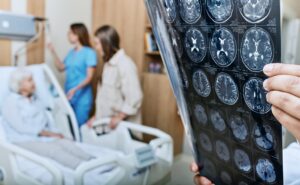
A stroke is a medical emergency that can cause devastating effects on the human body. Sadly, it is also one of the leading causes of death in the United States and a significant cause of serious disability for adults. According to the Centers for Disease Control and Prevention, more than 795,000 people in the U.S. suffer from a stroke every year. This statistic is alarming and highlights the importance of understanding the symptoms and risk factors associated with a stroke. Timely treatment can minimize the impact of a stroke and increase the chances of recovery. Being informed about the signs of a stroke can save someone’s life.
Signs of a Stroke
The most common signs of a stroke include sudden weakness or numbness on one side of the body, slurred speech or difficulty speaking, loss of vision, particularly in one eye, sudden dizziness or loss of balance, and a severe headache that comes on very quickly.
While these signs can vary depending on the severity of the stroke, recognizing them right away and seeking medical attention promptly can help improve the chances of recovery. Remember, time is crucial when it comes to treating a stroke, so don’t hesitate to call for help if you or someone you know is experiencing any of these warning signs. Early action could help to reduce complications, including brain damage.
Risk Factors
Understanding the risk factors associated with this disease is important to prevent and manage its occurrence. Risk factors of stroke can include high blood pressure, smoking, diabetes, high cholesterol, obstructive sleep apnea, cardiovascular disease (including heart failure, heart defects, heart infection or irregular heart rhythm), physical inactivity, and being obese. These factors can increase the likelihood of blood clots or brain hemorrhages leading to a stroke. Personal or family history of stroke, heart attack, or transient ischemic attack can also be risk factors.
By understanding these risk factors, individuals can take proactive steps to improve their overall health and reduce their risk of stroke. Early recognition and management of these risk factors can significantly decrease the likelihood of experiencing a stroke in the future.
Even if caught early, a stroke can cause temporary or permanent disabilities. Complications include loss of muscle movement, paralysis, difficulty talking or swallowing, memory loss, emotional problems, pain, and changes in behavior and self-care ability.
Stroke Rehabilitation
Stroke rehabilitation is a critical component of the recovery process after a stroke. It is a highly individualized process, as each individual’s recovery plan will depend on the specific part of the body or type of ability that was affected by the stroke. Some of the approaches to stroke rehabilitation may include physical therapy to help with mobility, speech therapy to improve communication, or occupational therapy to help regain independence in daily activities.
These rehabilitation programs are tailored to help patients regain and improve their physical, mental, and emotional abilities after a stroke. By committing to rehabilitation, stroke survivors can better recover their quality of life and regain independence.
Promoting Brain Function
Many factors can take a toll on brain function, affecting concentration, memory, and overall cognitive function. The Smart Pill can help counteract these effects through nine ingredients that help support, nourish, and maximize brain health and cognitive function. These include ginkgo biloba, huperzine A, bacopa extract, rosemary extract, and a B vitamin complex. This unique formula helps boost circulation, fight free radicals, and help to promote clear thinking.